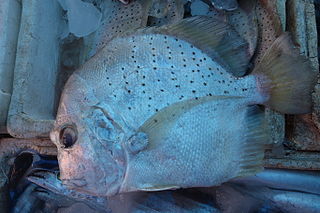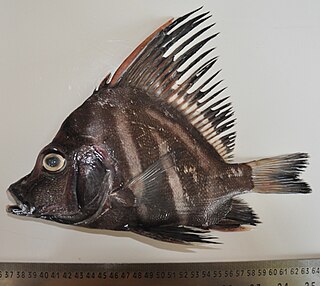
Mackerel is a common name applied to a number of different species of pelagic fish, mostly from the family Scombridae. They are found in both temperate and tropical seas, mostly living along the coast or offshore in the oceanic environment.

Carpet sharks are sharks classified in the order Orectolobiformes. Sometimes the common name "carpet shark" is used interchangeably with "wobbegong", which is the common name of sharks in the family Orectolobidae. Carpet sharks have five gill slits, two spineless dorsal fins, and a small mouth that does not extend past the eyes. Many species have barbels.

The Gonostomatidae are a family of mesopelagic marine fish, commonly named bristlemouths, lightfishes, or anglemouths. It is a relatively small family, containing only eight known genera and 32 species. However, bristlemouths make up for their lack of diversity with relative abundance, numbering in the hundreds of trillions to quadrillions. The genus Cyclothone is thought to be one of the most abundant vertebrate genera in the world.

Citharichthys is a genus of flatfish in the large-tooth flounder family, Paralichthyidae. They have both eyes on the left sides of their heads. They are native to the oceans around the Americas, with a single species, C. stampflii off the West African coast. Most are found in relatively shallow depths, but the genus also includes species found in deep water and species that enter fresh water.

Snipe eels are a family, Nemichthyidae, of eels that consists of nine species in three genera. They are pelagic fishes, found in every ocean, mostly at depths of 300–600 m (980–1,970 ft) but sometimes as deep as 4,000 m (13,000 ft). Depending on the species, adults may reach 1–2 m (39–79 in) in length, yet they weigh only 80–400 g (2.8–14.1 oz). They are distinguished by their very slender jaws that separate toward the tips as the upper jaw curves upward. The jaws appear similar to the beak of the bird called the snipe. Snipe eels are oviparous, and the juveniles, called Leptocephali, do not resemble the adults but have oval, leaf-shaped and transparent bodies. Different species of snipe eel have different shapes, sizes and colors. The similarly named bobtail snipe eel is actually in a different family and represented by two species, the black Cyema atrum and the bright red Neocyema erythrosoma.

Drepane is a genus of marine and brackish water ray-finned fishes, known commonly as the sicklefishes. It is the only genus in the monotypic percomorph family Drepaneidae. These fish occur in the Indian and western Pacific Oceans, and in the eastern Atlantic near Africa.

Tonguefishes are flatfish in the family Cynoglossidae. They are distinguished by the presence of a long hook on the snout overhanging the mouth, and the absence of pectoral fins. Their eyes are both on the left side of their bodies, which also lack a pelvic fin. This family has three genera with a total of more than 140 species. The largest reaches a length of 66 cm (26 in), though most species only reach half that size or less. They are found in tropical and subtropical oceans, mainly in shallow waters and estuaries, though some species are found in deep sea floors, and even a few in rivers.

Dichistius is a genus of centrarchiform ray-finned fishes, the galjoen fishes, native to the Atlantic coast of southern Africa and the Indian Ocean coast of southern Africa. Growing to lengths of 80 cm (31 in) and 35 cm (14 in), both known species are popular commercial and game fishes.
Helicophagus is a genus of shark catfishes native to Southeast Asia.

Plotosus is a genus of eeltail catfishes native to the Indian Ocean, the western Pacific Ocean and New Guinea.
Phyllonemus is a genus of claroteid catfish native to Africa where it is only found in Lake Tanganyika.

The longnose hawkfish is a species of marine ray-finned fish, a hawkfish belonging to the family Cirrhitidae. It is found on tropical reefs of the Indian Ocean and the Pacific Ocean, where it can be found at depths around 10 to 100 m. It prefers the steep outer slopes of the reefs amongst gorgonians and black corals. This species can reach 13 cm (5.1 in) in total length. It can also be found in the aquarium trade. It is currently the only known member in its genus.

Platax is a genus of Indo-Pacific, reef-associated fish belonging to the family Ephippidae. There are currently five known extant species generally accepted to belong to the genus. They are one of the fish taxa commonly known as "batfish".

Fish are very diverse animals and can be categorised in many ways. Although most fish species have probably been discovered and described, about 250 new ones are still discovered every year. According to FishBase about 34,800 species of fish had been described as of February 2022, which is more than the combined total of all other vertebrate species: mammals, amphibians, reptiles and birds.
Lepidopygopsis typus, the Peninsular hilltrout, is a species of cyprinid fish endemic to Kerala, India where it is only known from Periyar River and Periyar Lake. This species can reach a length of 25 centimetres (9.8 in) TL. It is currently the only known member of its genus.

the African leaffish is a species of African leaffish native to fresh waters of western Africa. Although placed in the family Nandidae by FishBase and by the 5th Edition of Fishes of the World many recent authorities place Polycentropsis in Polycentridae.

The sailfin armourhead, also known as the threebar boarfish, is a species of marine ray-finned fish, an armourhead from the family Pentacerotidae which is native to the Indian Ocean and the western Pacific Ocean. It is an inhabitant of rocky reefs in deeper waters of 40 to 421 m in depth. This species grows to a length of 42 cm (17 in), though most are only around 20 cm (7.9 in). It is a commercially important species, and is the only known member of its genus.














